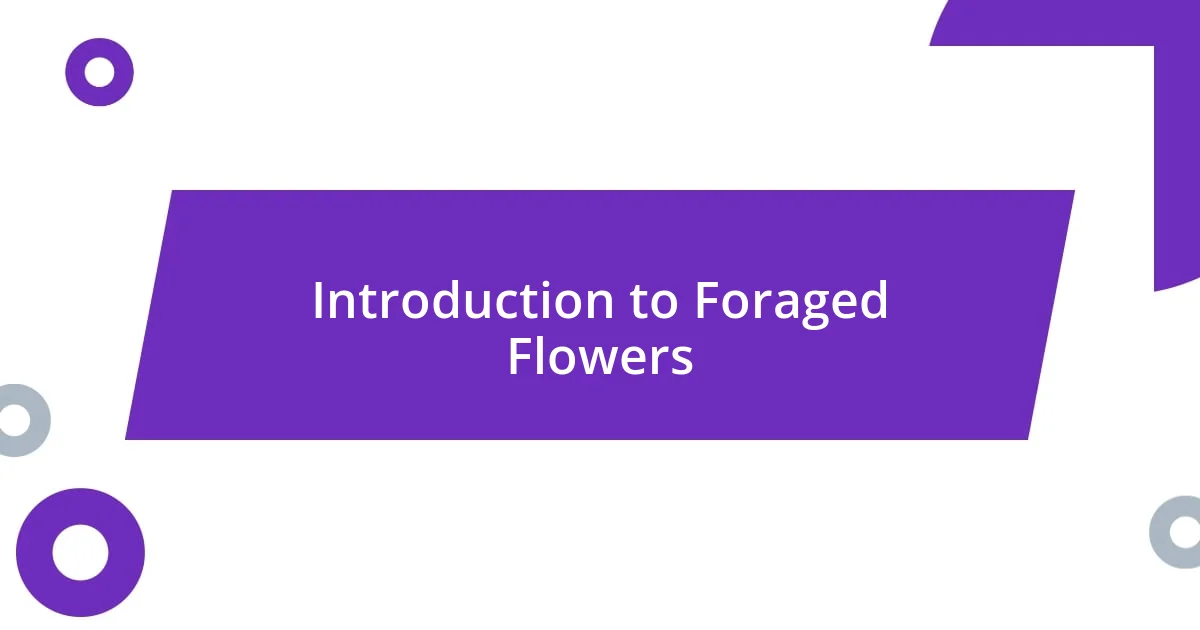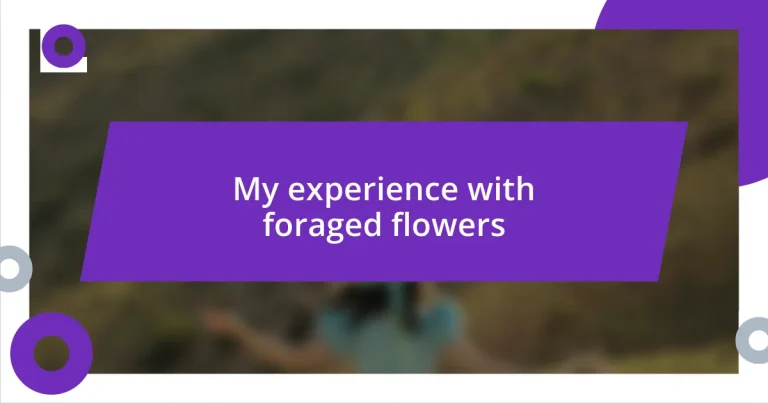Key takeaways:
- Foraging flowers enhances culinary creativity, allowing for unique flavors and meaningful conversations about nature’s offerings.
- Understanding the characteristics and proper identification of edible flowers is essential to safely enjoying foraged delights.
- Respectful harvesting techniques and timing contribute to sustainable foraging, fostering a deeper connection with the environment.

Introduction to Foraged Flowers
Foraged flowers represent a delightful intersection of nature and creativity, allowing us to connect more profoundly with our surroundings. I remember my first experience foraging; the thrill of discovering vibrant blooms in unexpected places felt almost like finding hidden treasures in my own backyard. Can you imagine the joy of picking wild violets or dandelions and knowing they’re not just beautiful, but also edible?
As I began my journey, I quickly learned that each foraged flower carries its own story and flavor profile. For instance, I was surprised by the peppery kick of nasturtiums and the delicate sweetness of clover flowers. Have you ever thought about using flowers in salads or desserts? It’s such a simple way to elevate everyday dishes and share a slice of nature’s beauty at the same time.
The experience goes beyond just taste; it’s about the mindfulness that comes with foraging. There’s something incredibly grounding about choosing flowers during a hike and being present in that moment. Each bloom I encounter sparks a sense of wonder and prompts me to reflect on the beauty that often goes unnoticed. What if we all paused to appreciate these small wonders in our lives?

Benefits of Foraging Flowers
Foraging flowers offers a delightful way to enhance our meals with fresh, unique flavors. I still remember my first floral salad; the vibrant nasturtiums added a surprising zing that transformed ordinary greens. Sharing that dish with friends turned into a joyful conversation about the details of each flower—it’s amazing how foraged ingredients can lead to storytelling at the dinner table.
Additionally, my foraging experiences have led me to a deeper appreciation for the environment. Each time I venture outdoors and gather petals, I feel a connection to nature that fosters mindfulness. It’s a reminder to slow down and savor the simple victories while exploring the natural world. I urge you to try foraging; it could be the key to reconnecting with something precious we often overlook.
Not to mention, foraged flowers are a fantastic way to promote biodiversity. I’ve found that spreading the word about wild blooms can inspire others to appreciate their local ecosystems. Each flower I discover feels like an invitation to nurture the environment. When we incorporate local flora into our lives, we create a ripple effect that celebrates and preserves nature’s beauty.
| Benefits of Foraging Flowers | Personal Insights |
|---|---|
| Enhances culinary creativity | Transform ordinary meals and spark conversations |
| Fosters mindfulness | Reconnects with nature and promotes tranquility |
| Promotes biodiversity | Encourages care for local ecosystems |

Identifying Edible Flower Varieties
When it comes to identifying edible flower varieties, I’ve learned that it’s not just about recognition; it’s also about understanding their unique traits. For instance, I once mistook a blooming hawthorn for something else during a hike, only to find out later that its delicate white petals are not only beautiful but also delicious. Each time I forage, I’m reminded to observe details like color, fragrance, and even the habitat where these flowers grow—these elements provide essential clues to their edibility.
Here’s a quick list of some commonly foraged edible flowers to consider:
- Nasturtiums: Bright, peppery, perfect for salads.
- Chives: Beautiful purple blooms with a mild onion flavor.
- Pansies: Sweet, colorful flowers ideal for garnishing desserts.
- Dandelions: Every part is edible, from roots to blossoms.
- Calendula: Adds a marigold-like zest to dishes.
I vividly recall the first time I came across dandelions in my backyard; it felt almost magical to realize that what I had once viewed as a pesky weed could bring flavor to my meals and even act as a practical remedy. Finding these flowers adds a layer of adventure to my cooking, urging me to explore and experiment in fascinating ways. Remember, the beauty lies in knowing what’s safe to eat and sharing these joyful discoveries with others.

Best Seasons for Foraging Flowers
The best seasons for foraging flowers truly depend on the climate you’re in, but I’ve found that late spring through early summer is often the most rewarding time. As the weather warms up, a vibrant palette of blooms begins to paint the landscape. I’m always excited to plan my outings around this period, knowing that I’ll encounter blossoms like violets and elderflowers just waiting to be discovered.
Fall is another wonderfully underrated season for foraging. I still vividly remember a crisp autumn day when I stumbled upon wild asters, their delicate petals echoing the colorful leaves surrounding them. The joy of foraging in fall is unique; the crisp air energizes each adventure. Can you imagine gathering edible flowers while feeling the warmth of the sun mingling with the cool breezes? There’s something utterly invigorating about it.
I’ve also noticed that flowers can reveal themselves at different times depending on local conditions. For instance, after a warm spell in early spring, I once encountered a beautiful patch of wild garlic blossoms. It made me ponder—what if the flowers I’ve overlooked during my strolls could become delightful additions to my kitchen? Each season seems to have its own secret treasures just waiting to be unearthed, enriching both my culinary explorations and my connection to the rhythm of nature.

Techniques for Proper Flower Harvesting
When it comes to harvesting flowers, timing is crucial. I’ve learned that the best time to forage is early in the morning after the dew has dried but before the heat of the day sets in. This is when the flowers are at their freshest, and I feel a sense of excitement when I see petals still holding the morning light. It’s as if the flowers are just waiting for me to discover them.
I often use a pair of sharp scissors or pruning shears for a clean cut—this ensures the flower can continue to thrive after I’ve taken what I need. In one instance, while gathering violet blooms, I was careful to snip only a few from each cluster, which not only felt respectful to nature but also allowed me to leave plenty for future foragers. Have you ever thought about how a gentle approach can encourage sustainability in foraging? I believe it’s vital to maintain a balance, allowing the plants to flourish so they can be enjoyed time and time again.
Another technique I swear by is to only harvest flowers that are healthy and fully opened. I remember one afternoon realizing I had missed some lovely elderflowers simply because I was too focused on the ones that looked the best. This taught me patience; not every flower has to be perfect in order to be delightful. It’s fascinating to think about how the imperfections can sometimes be the most beautiful and flavorful, wouldn’t you agree? Embracing this mindset not only enriches my foraging experience but also deepens my appreciation for the natural world.














